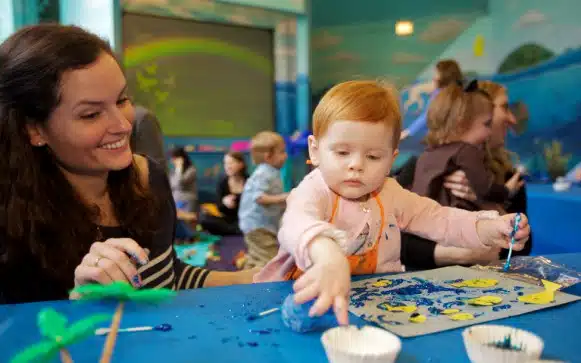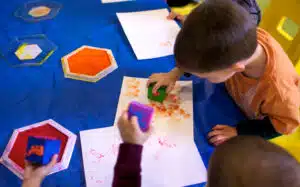Take the stress out of your little Picasso’s first art experience by following Miss Becca’s 5 steps to consistently positive toddler art projects!
Toddler art projects can seem really daunting. Here’s your little one who makes a huge mess eating yogurt and you’re about to give him paint? It’s totally natural to feel overwhelmed. Don’t be afraid of art — embrace it and hand over the paintbrush. It’s so important for your child’s development. Not only are you working on sensory exposure, but also your child is working the muscles he/she will need to hold a pencil and write his/her name.
Between teaching art and pre-preschool classes at Bubbles Academy, plus hanging out with the little ones in my personal life, I do 10-12 toddler art projects a week. That’s a lot of finger paint! Through trial and error, I’ve discovered five steps that make toddler art projects a success every time.
(1) Spark Their Interest!
They have to WANT to do the project. This is the most important part of any toddler art project. If they aren’t interested, put the project away and try again later. That said, you can entice them with new materials, songs, fun colors, or by doing a project based on something your child loves. I babysit a little lady who is obsessed with kitty cats. When we do art together, we make a cat or we meow while we paint. It’s fun and so much easier than trying to strap her to a chair to use a paintbrush.
A lot of toddlers aren’t interested in art until you dip a car in paint and let them make tracks on the paper. Try to find an “in” with your little artist.
One of the most important parts of development in young people is motivation. You have to want to crawl to crawl, the same is true of fine motor development. You have to want to hold that paintbrush before you pick it up. Find fun ways to motivate your toddler to create!
- Tip: Check out this post on Tinkerlab about no mess art projects you can do at home! Or you can check out our Pinterest board Artsy Experiments for projects that will motivate your child.
(2) Find the Right Place!
To really engage in an activity, your child needs to feel comfortable and create in a space that is distraction free. Just as adults thrive in a de-cluttered office, try to limit distractions in your art environment. The kicker for toddler art projects — it needs to be a space where your little one will stay for the duration of the project. Feel free to think outside of the box. Let your child do a project on the floor if he/she is not feeling the chair today.
- Tip: I love taping paper to the wall and letting little ones stand. Standing allows them to bend and reach for supplies on the ground, which sneaks a little gross motor development in there and satisfies your little one’s wiggles.
(3) Set Your Supplies for Success!
Instead of handing the brush to your toddler, put all the supplies out in your workspace within your toddler’s reach. This encourages little ones to pick which hand they will use to create, which will ultimately benefit them as they develop hand dominance. Because hand dominance isn’t set until age five for some children, you want to give your developing toddler freedom to experiment with both hands.
North Shore Pediatric posted this interesting article about hand dominance on their blog. Putting the supplies out for your young artist to choose supports our next step…
(5) Give Your Child Creative Freedom
Children choose what tools to use! Allowing your child to make the choice to pick up a paintbrush or crayon gives him/her more ownership over the project. I recently read an interesting article about student driven learning by Joshua Davis.
The article sites a study by MIT and the University of Louisville, which observed children that were given various toys. The results:
“The kids were presented with a toy that could squeak, play notes, and reflect images, among other things. For one set of children, a researcher demonstrated a single attribute and then let them play with the toy. Another set of students was given no information about the toy. This group played longer and discovered an average of six attributes of the toy; the group that was told what to do discovered only about four. A similar study at UC Berkeley demonstrated that kids given no instruction were much more likely to come up with novel solutions to a problem.”
Let your child drive the project. Try stepping back and give him or her room to discover.
- Tip: Practice using the word, “Yes!” for all his or her choices (within reason) — “You’re stacking all those stickers on top of each other. I love that!”
(5) Put it on Display and Talk About It!
Put that masterpiece in their room and talk about it before naptime, or place it on your refrigerator and visit it during lunch. Praise the parts you love about their picture. Maybe he/she mixed some colors together to make a new color — talk about that.
Make the process of creating that project a story and tell it often. Share the artwork with a spouse or other caregiver, “Chloe made this beautiful picture today. She picked these colors on her own, and used a Q-tip to paint this part. I really love how she swirled the paint right here.” Not only are you exercising your child’s memory, but also you’re encouraging storytelling, boosting their self-esteem and building up excitement for their next creation.
Have fun creating amazing toddler art projects in your home, art classes and schools.
Tweet @BubblesAcademy with your at home creations!

Becca Drew
Becca Drew Emmerich is the Artistic & Curriculum Director of Bubbles Academy. With a dynamic background in youth theatre, Becca leads the development and teaching of our curriculum.

